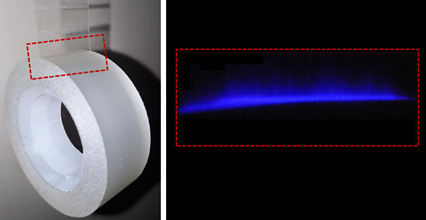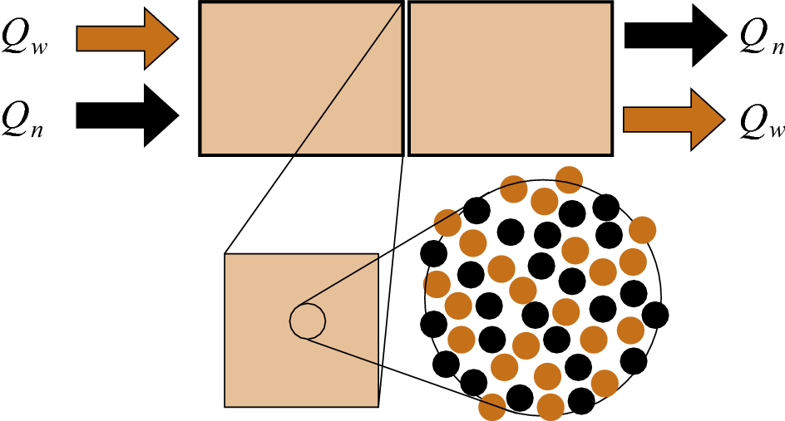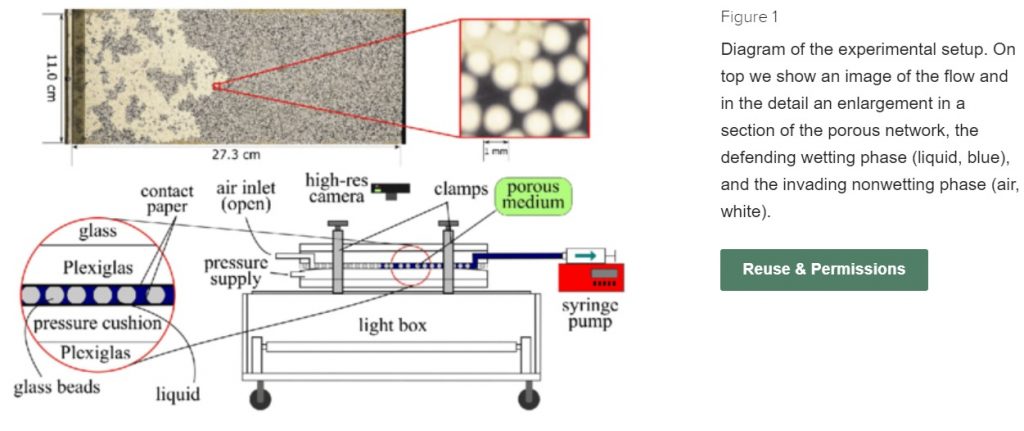A significant number of PoreLab articles are published in highly-cited peer-reviewed international journals such as Physical Review Letters, Europhysics Letters, Journal Of Non-Equilibrium Thermodynamics and Journal Of Petroleum Science And Engineering. Many of the articles have high citation indices and journal impact factors reflect well the published work of the centre.
Featured Publications:
The catastrophic propagation of fractures explained by their extreme temperature.
Or how to generate a small ‘sun’ with some adhesive tape
The fractoluminescence phenomenon, that is, the emission of visible light when a material breaks, is generally unknown from the general public. It is yet rather easy to observe it, as one may only need to quickly unroll some adhesive tape in the dark (as shown in the picture). This intriguing phenomenon can be explained by the extreme temperature – thousands of degrees – potentially reached very locally by the glue, at the place where it detaches from the roll. An adhesive that brutally fails could thus be hotter than the surface of our sun!
More than an amusing anecdote, such a process helps to better understand the brittleness of matter. Is not a potential menace for any of our everyday objects (from the screen of our phones to the arches of our bridges) the sudden growth of a fracture? This threat also lies on the very rocks on which we live, in which fractures sometimes generate dreadful earthquakes.
By studying the dynamics of the peeling of tape, but also that of the rupture of acrylic glass (PMMA), we show that sudden fractures can arise from an intense thermal dissipation. We predict that the quicker a crack is, the hotter it becomes. And, reciprocally, a warming crack accelerates. Indeed, the molecular agitation (whose intensity is related to the temperature) allows the rupture of the atomic bonds which keep solid matter together. This phenomenon could thus quickly amplify; a fracture can then suddenly reach thousands of degrees, and thus propagate dramatically.

Picture: A standard adhesive tape (to the left) quickly unrolled in the dark (image on the right). The dashed rectangles highlight the same area in both pictures. The blue light could arise from an adhesive temperature reaching about 7000°C
Read more about the subject in the following publication:
T. Vincent-Dospital, R. Toussaint, S. Santucci, L. Vanel, D. Bonamy, L. Hattali, K.J. Måløy (2020). How heat controls fracture: the thermodynamics of creeping and avalanching cracks. Soft Matter. First published 28 September 2020. DOI: https://doi.org/10.1039/D0SM01062F
Collection of Disks Mimics Earthquakes: “Continuously sheared granular matter reproduces in detail seismicity laws”
An interesting reading authored by S. Lherminier, R. Planet, V. Levy dit Vehl, G. Simon, L. Vanel, K.J. Måløy and O. Ramos on how 2D disks under stress replicate earthquakes. You can read more about this here

“Relations between Seepage Velocities in Immiscible, Incompressible Two-phase Flow in Porous Media”
The paper from A. Hansen, S. Sinha, D. Bedeaux, S. Kjelstrup. M. Aa. Gjennestad and M. Vassvik on “Relations between Seepage Velocities in Immiscible, Incompressible Two-phase Flow in Porous Media” has become the most downloaded paper ever in Transport in Porous Media, the main journal in porous media research, since 1986.
We demonstrate in the paper how certain easily overlooked symmetries in immiscible two-phase flow in porous media lead to new equations constraining how the two fluids move. (A symmetry is a property that is unchanged after transforming the system.) The ultimate goal of this work is to be able to present a complete theoretical description of immiscible two-phase flow in the limit where the porous medium may be seen as a continuum, i.e. the scales where relative permeability theory today reigns
Abstract: Based on thermodynamic considerations, we derive a set of equations relating the seepage velocities of the fluid components in immiscible and incompressible two-phase flow in porous media. They necessitate the introduction of a new velocity function, the co-moving velocity. This velocity function is a characteristic of the porous medium. Together with a constitutive relation between the velocities and the driving forces, such as the pressure gradient, these equations form a closed set. We solve four versions of the capillary tube model analytically using this theory. We test the theory numerically on a network model.

Fig. 1
In the upper part of the figure, we see the REV from the side. There is a flow Q=Qw+Qn across it. An imaginary cut is made through the REV in the direction orthogonal to the flow. In the lower left corner, the surface of the imaginary cut is illustrated. A magnification of the surface of the cut is shown in the lower right corner. The pore structure is illustrated as brown and black circles. The pores that are brown are filled with wetting fluid, and the pores that are black are filled with non-wetting fluid. The wetting fluid-filled pores form in total an area Aw, and the non-wetting fluid-filled pores form in total an area An. The total pore area of the imaginary cut in the lower left corner is Ap=Aw+An=Aϕ
“Verification of a Dynamic Scaling for the Pair Correlation Function during the Slow Drainage of a Porous Medium”
M. Moura, K. J. Måløy, E. G. Flekkøy, and R. Toussaint. “Verification of a Dynamic Scaling for the Pair Correlation Function during the Slow Drainage of a Porous Medium“. This paper has just been published by PRL (Physical Review Letters). In this paper we have experimentally verified a 30 years long prediction about how the relative probability of invasion of a pore in a porous medium varies with space and time. When a material full of pores (like a porous rock or a sponge) is soaked in a fluid and another fluid is forced into it, an interesting dynamics arises in which the invading fluid sequentially displaces the other one out of the pores. In the late 80s a group of researchers employed computer simulations to quantify the relative probabilities of such pore displacements, making numerical predictions about how this probability varies with space and time. – By using synthetic porous samples and modern image analysis techniques, we have been able to finally verify those predictions experimentally and to give a full theoretical explanation for the observations. The increased understanding of this kind of phenomena is relevant for many fields in which one fluid displaces another from a porous network, such as CO2 storage in subsea rocks and the remediation of contaminated soils. A popular science article about this work was published in Titan.

“Critical Behavior in Porous Media Flow”
M. Moura, K. J. Måløy and R. Toussaint. Critical Behavior in Porous Media Flow, 2017 EPL (Europhysics Letters), Volume 118. The article has been published by EPL (Europhysics Letters). This was project in which we have addressed the statistics of burst invasion events in porous media and also the power spectrum of pressure fluctuations associated with the bursts. The illustration shows the flow from left to right, during approx 82 h. Bursts color coded by their size normalized by a typical pore area (top) and randomly (bottom). The vast blue areas in the top image contain many smaller bursts (detail)
Poster: Fluid Topology in Drainage and Imbibition: Pore Scale Imaging, by: Synchrotron Tomography. Hamid H. Khanamiri, Ole Torsæter, Georg J. B. Voss.

